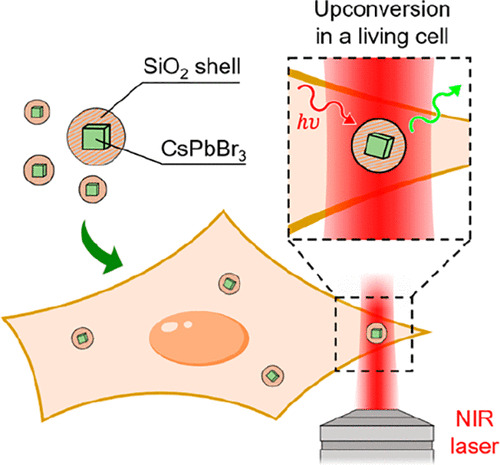当前位置:
X-MOL 学术
›
J. Phys. Chem. Lett.
›
论文详情
Our official English website, www.x-mol.net, welcomes your feedback! (Note: you will need to create a separate account there.)
Halide Perovskite Nanocrystals with Enhanced Water Stability for Upconversion Imaging in a Living Cell
The Journal of Physical Chemistry Letters ( IF 5.7 ) Pub Date : 2021-09-13 , DOI: 10.1021/acs.jpclett.1c01968 Pavel M Talianov 1 , Oleksii O Peltek 1 , Mikhail Masharin 1 , Soslan Khubezhov 1, 2 , Mikhail A Baranov 1 , Audrius Drabavičius 3 , Alexander S Timin 4, 5 , Lev E Zelenkov 1 , Anatoly P Pushkarev 1 , Sergey V Makarov 1 , Mikhail V Zyuzin 1
The Journal of Physical Chemistry Letters ( IF 5.7 ) Pub Date : 2021-09-13 , DOI: 10.1021/acs.jpclett.1c01968 Pavel M Talianov 1 , Oleksii O Peltek 1 , Mikhail Masharin 1 , Soslan Khubezhov 1, 2 , Mikhail A Baranov 1 , Audrius Drabavičius 3 , Alexander S Timin 4, 5 , Lev E Zelenkov 1 , Anatoly P Pushkarev 1 , Sergey V Makarov 1 , Mikhail V Zyuzin 1
Affiliation

|
Halide perovskite nanomaterials are widely used in optoelectronics and photonics due to their outstanding luminescent properties, whereas their strong multiphoton absorption makes them prospective for bioimaging. Nonetheless, instability of perovskites in aqueous solutions is an important limitation that prevents their application in biology and medicine. Here, we demonstrate fluorescence and upconversion imaging in living cells by employing CsPbBr3 nanocrystals (NCs) that show an improved water-resistance (at least for 24 h) after their coating as individual particles with various silica-based shells. The obtained phTEOS-TMOS@CsPbBr3 NCs possess high quality, which we confirm with high-resolution transmission and scanning transmission electron microscopy, X-ray diffraction analysis, Fourier-transform infrared and energy-dispersive X-ray spectroscopies, as well as with fluorescence optical microscopy. The developed platform can make the halide perovskite NCs suitable for various bioimaging applications.
中文翻译:

具有增强水稳定性的卤化物钙钛矿纳米晶体用于活细胞中的上转换成像
卤化物钙钛矿纳米材料由于其出色的发光特性而被广泛应用于光电子学和光子学,而其强大的多光子吸收使它们具有用于生物成像的前景。尽管如此,钙钛矿在水溶液中的不稳定性是阻碍其在生物学和医学中应用的重要限制。在这里,我们通过使用 CsPbBr 3纳米晶体 (NCs)在活细胞中展示荧光和上转换成像,这些纳米晶体在将其作为具有各种二氧化硅基壳的单个颗粒涂覆后显示出改进的防水性(至少 24 小时)。得到的phTEOS-TMOS@CsPbBr 3NC 具有高质量,我们通过高分辨率透射和扫描透射电子显微镜、X 射线衍射分析、傅里叶变换红外和能量色散 X 射线光谱以及荧光光学显微镜证实了这一点。开发的平台可以使卤化物钙钛矿 NCs 适用于各种生物成像应用。
更新日期:2021-09-23
中文翻译:

具有增强水稳定性的卤化物钙钛矿纳米晶体用于活细胞中的上转换成像
卤化物钙钛矿纳米材料由于其出色的发光特性而被广泛应用于光电子学和光子学,而其强大的多光子吸收使它们具有用于生物成像的前景。尽管如此,钙钛矿在水溶液中的不稳定性是阻碍其在生物学和医学中应用的重要限制。在这里,我们通过使用 CsPbBr 3纳米晶体 (NCs)在活细胞中展示荧光和上转换成像,这些纳米晶体在将其作为具有各种二氧化硅基壳的单个颗粒涂覆后显示出改进的防水性(至少 24 小时)。得到的phTEOS-TMOS@CsPbBr 3NC 具有高质量,我们通过高分辨率透射和扫描透射电子显微镜、X 射线衍射分析、傅里叶变换红外和能量色散 X 射线光谱以及荧光光学显微镜证实了这一点。开发的平台可以使卤化物钙钛矿 NCs 适用于各种生物成像应用。


























 京公网安备 11010802027423号
京公网安备 11010802027423号